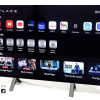Projectors provide the ultimate home theater experience. Nothing else comes as close to truly re-creating the viewing experience of a movie theater. Imagine the leathery hide of a Tyrannosaurus rex, up close and personal. Or a tight shot of Norah Jones at the piano that reveals her freckles. Picture a 240-pound linebacker barreling straight at you. Or a video game villain swinging a sword big enough to splinter your coffee table. Front-projection TV delivers all that and more — images bursting with cinematic detail and color across a larger-than-life screen measured in feet, not inches.
Enjoy your favorite TV shows, sports, and video games on a screen measuring up to 10 feet. Invite friends over for the latest Blu-ray release.
Projectors: The basics
A front-projection TV is a two-piece system: the projector and the screen. Today’s digital projectors use LCD or LCoS technology. Many projectors are compact and lightweight enough to be considered portable. They’re a snap to set up and use, and best of all, they’re much more affordable than old CRT projectors.
You can place a digital projector on a coffee table or out of view on a bookcase, or you can mount it to the ceiling (we have custom mounts for most of the models we carry). Projector screens come in a variety of sizes, and can be free-standing, wall-mounted, or retractable (manual or motorized). Displaying images on a wall can look OK, but a screen delivers a smoother, more consistent image, and helps any projector perform at its best.
Since the image is projected onto a separate screen, everything inside a projector’s compact case is dedicated to creating the sharpest, most realistic picture possible. You’ll find a high-resolution imager (DLP, LCD, or LCoS), an ultra-high-intensity lamp, superb scaling circuitry, top-grade optics, and a wide selection of video inputs. What you won’t find is a built-in screen or stereo speakers. Also, a projector has no built-in TV tuner of any kind, but it will display signals from an HDTV tuner, satellite receiver, or cable box.
Projectors not only deliver the largest — and some of the highest-quality — images available for home theater, they’re also frequently a better value than other display types if you figure the cost per inch of screen. Most projectors can display signals from a video game console as well as a PC — it’s an unbelievably engaging gaming experience. And because you’re projecting an image onto a wall or separate screen, there’s no glass involved, so you’ll see absolutely no reflection or glare from the screen.
So pass the popcorn, dim the lights, and get ready for real home theater.
Is a projector for you?
There are a couple of key things to be aware of if you’re considering a projector. First, your room lighting: for the best projector performance in a home theater, you should be able to substantially reduce or eliminate light in the room, whether it’s daylight or room lights. Rooms with few windows are good candidates. If you plan to use a projector in a room that gets a lot of sunlight, you may need to limit your viewing to after dark, or consider installing blackout shades on the windows. Because of the lighting issue, projector owners generally use other TVs for some or most of their everyday viewing, and reserve the projector for “event” viewing or gaming.
Second, your viewing habits and the life of your projector’s lamp: LCD and DLP projectors typically have a lamp life of 2000-4000 hours, compared to 8000 hours for digital big-screen rear-projection models. The hour rating actually represents the lamp’s “half-life” — the point where its brightness has diminished by half. A lamp will still work past its half-life, but it will continue to gradually lose brightness. When you replace the lamp (it’s easily user-replaceable), picture quality returns to like-new brightness. But you won’t be able to simply run to the hardware store for a lamp. These projectors use special high-pressure lamps that cost between $200 and $500. Projector owners who primarily watch movies and special events run their projectors an average of about 8 hours a week. For a projector with a 2000-hour lamp, that translates to 4-5 years of use. But if you use a projector as your main TV, logging say 4 hours per day, you’ll be looking at lamp replacement in under a year and a half.
Features to look for when shopping for a projector
These days, the projectors from major manufacturers all look impressive. But of course, each has its own unique strengths and weaknesses, and no single model will be the best choice for all rooms and signal sources. You can get a general idea about how a projector will perform by comparing these three key specifications.
Resolution: For digital projectors, resolution is the number of pixels measured from side to side and top to bottom of the imaging chip. High-definition projectors will have resolutions of 720p or 1080p. Projectors with greater resolution can more accurately reproduce high-resolution signals; because each pixel is smaller, images look more seamless, with less noticeable “pixel structure.” A projector’s built-in scaler will upconvert or downconvert all incoming signals to precisely match its “native resolution.” See our article about HDTV resolution for more info.
Contrast ratio: This measures the difference between the whitest whites and the blackest blacks a projector can show. A higher contrast ratio makes it possible to display deeper blacks and more subtle color detail. Good contrast is critical for home theater projectors. In fact, many models include multiple lamp settings that let you reduce brightness and boost contrast ratio for optimum viewing in a darkened room.
Light output (brightness): Home theater projectors typically have brightness ratings of 700-2500 lumens. All projectors have plenty of brightness for watching movies in a dimly-lit or darkened room. A higher brightness rating will come in handy for viewing when there’s more ambient room light. It’s also helpful if you’re projecting onto a wall (it’s less reflective than a screen), or if you’re displaying an extra-large image (110″ across or larger).
Connectivity: Projectors have the same video inputs you find on most HDTVs, including HDMI and component video for high-def content.

→ Continue reading about projector placement tips.

by Steve Kindig, Crutchfield.com. All rights reserved. (reprinted with permission, originally posted April 28, 2009)





























